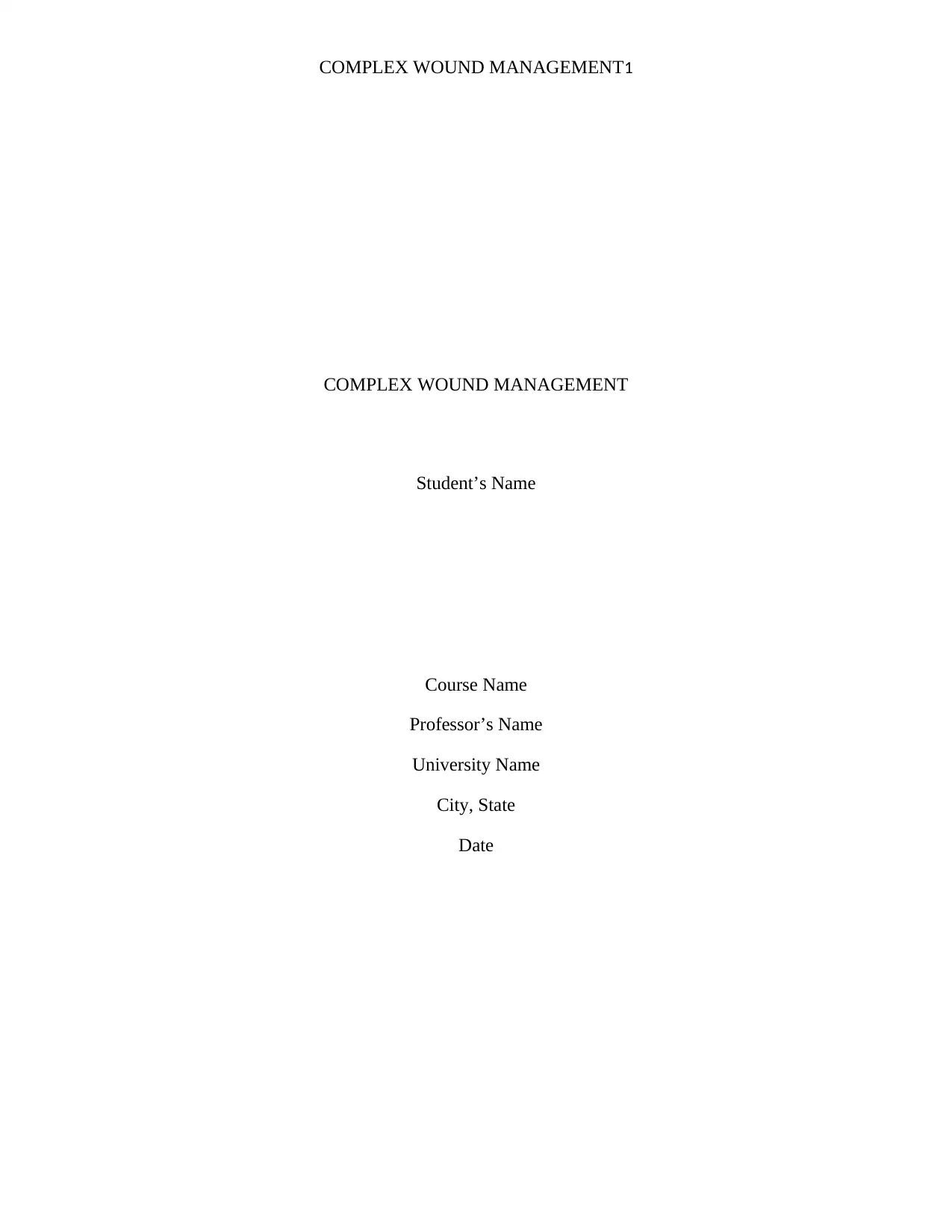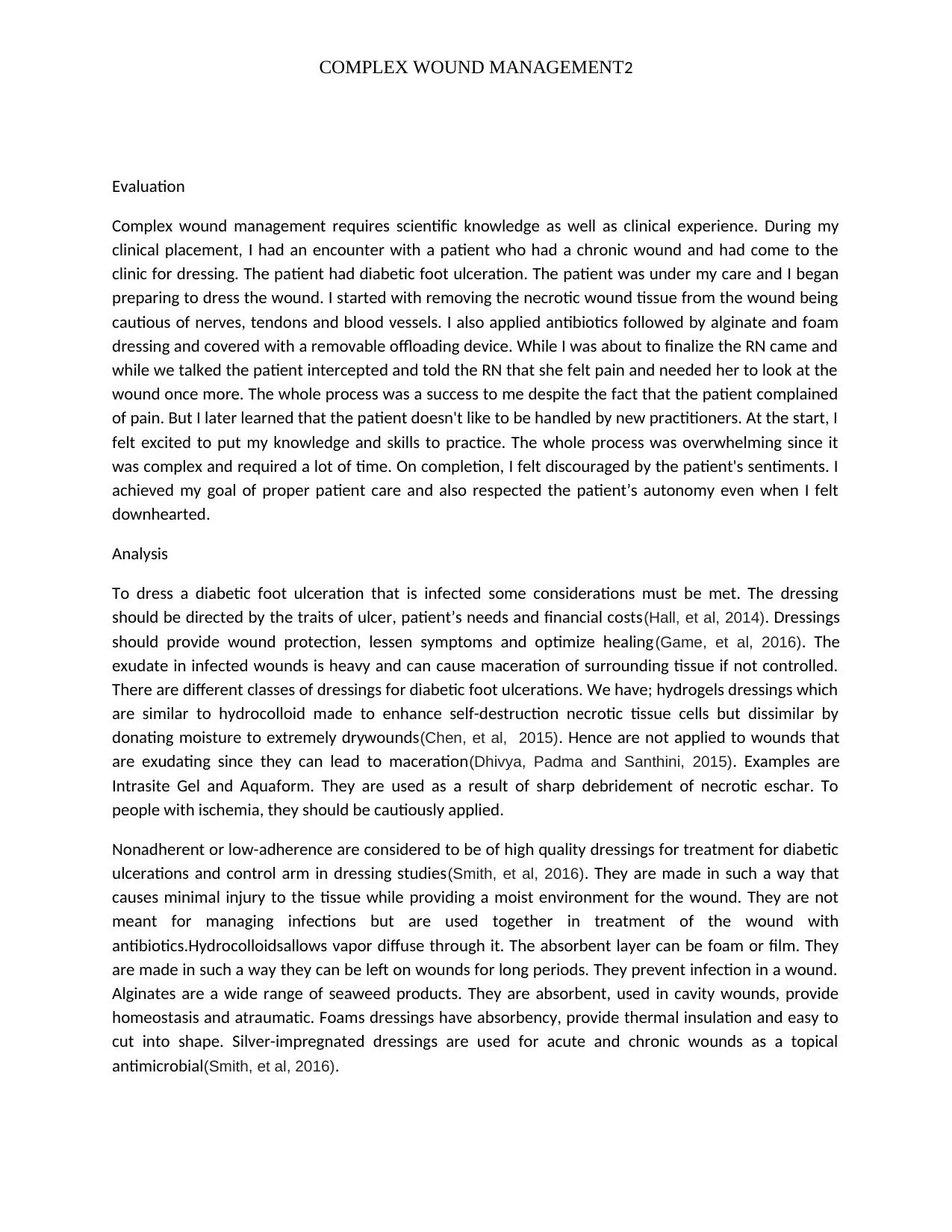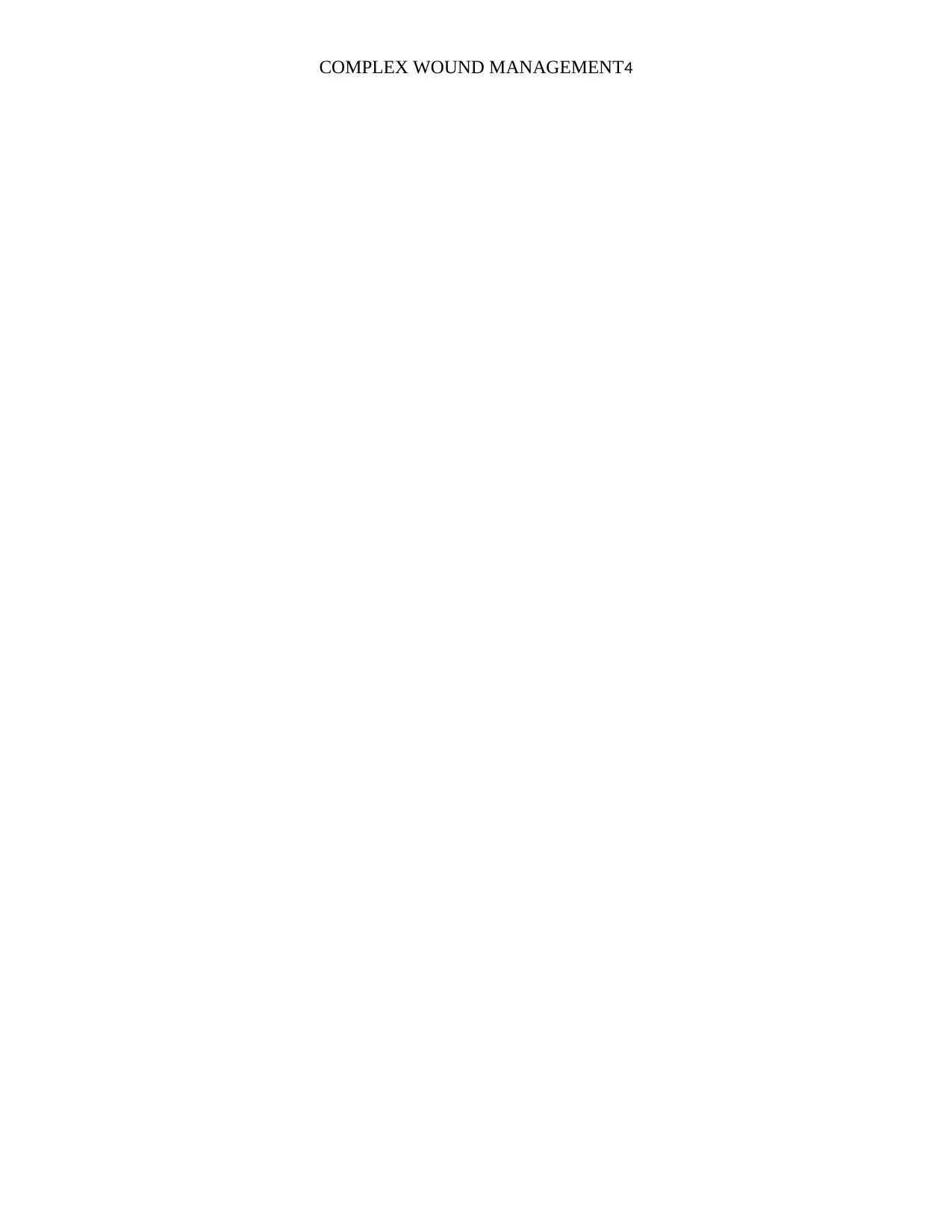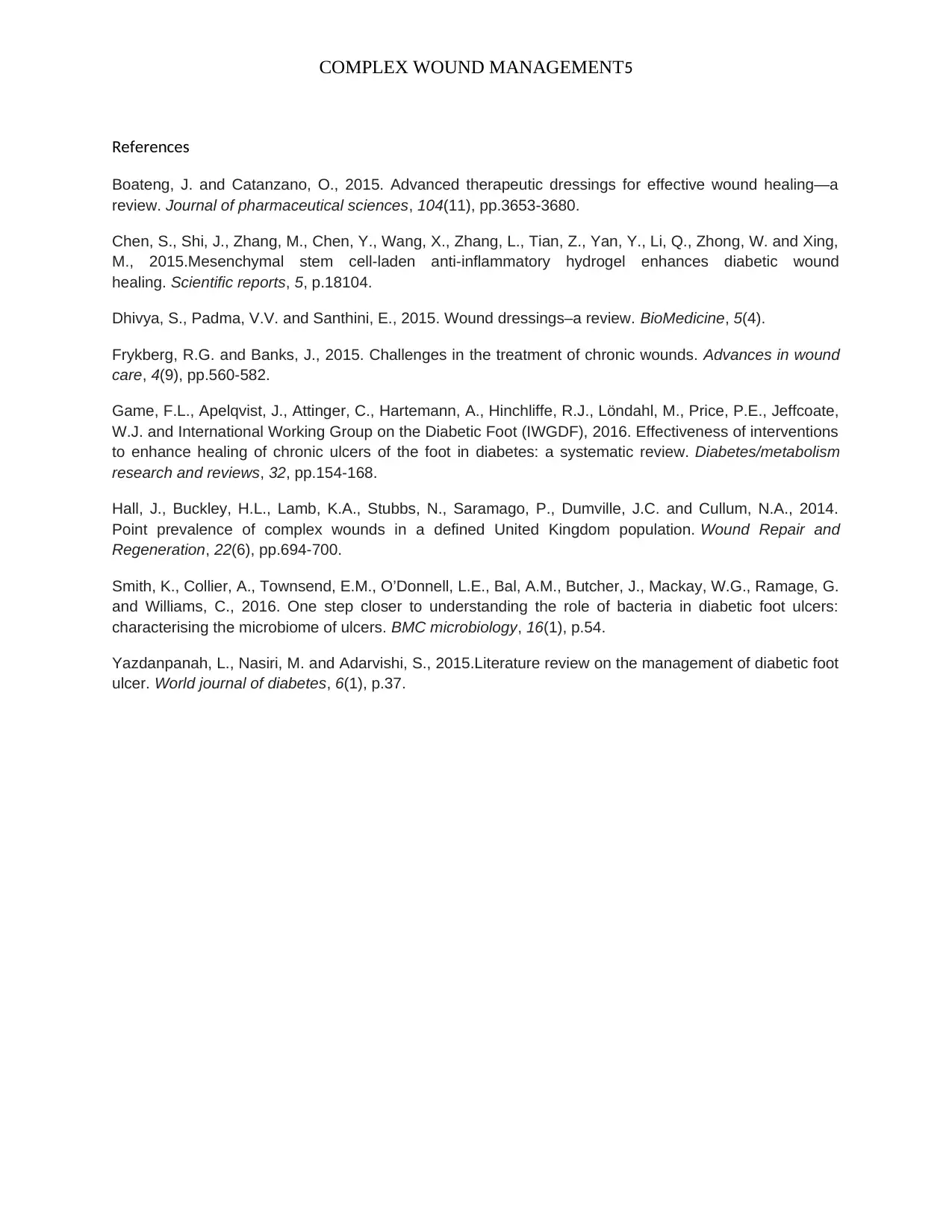Clinical Experience: Reflective Report on Complex Wound Management
VerifiedAdded on 2023/06/04
|5
|1616
|202
Report
AI Summary
This report reflects on a clinical experience involving the management of a diabetic foot ulcer. It details the evaluation of the dressing process, including initial excitement, challenges faced, and feelings of discouragement due to patient feedback. The analysis section reviews current best practices in wound care, emphasizing the importance of appropriate dressing selection based on ulcer characteristics, patient needs, and cost-effectiveness. Various types of dressings, such as hydrogels, non-adherent dressings, hydrocolloids, alginates, foams, and silver-impregnated dressings, are discussed. The report concludes with an action plan focused on improving communication skills for patient-centered care and collaborative learning with other healthcare professionals. The experience highlights the importance of continuous learning and adaptation in clinical practice to achieve optimal patient outcomes. Desklib offers a wealth of similar documents and resources for students.

COMPLEX WOUND MANAGEMENT1
COMPLEX WOUND MANAGEMENT
Student’s Name
Course Name
Professor’s Name
University Name
City, State
Date
COMPLEX WOUND MANAGEMENT
Student’s Name
Course Name
Professor’s Name
University Name
City, State
Date
Paraphrase This Document
Need a fresh take? Get an instant paraphrase of this document with our AI Paraphraser

COMPLEX WOUND MANAGEMENT2
Evaluation
Complex wound management requires scientific knowledge as well as clinical experience. During my
clinical placement, I had an encounter with a patient who had a chronic wound and had come to the
clinic for dressing. The patient had diabetic foot ulceration. The patient was under my care and I began
preparing to dress the wound. I started with removing the necrotic wound tissue from the wound being
cautious of nerves, tendons and blood vessels. I also applied antibiotics followed by alginate and foam
dressing and covered with a removable offloading device. While I was about to finalize the RN came and
while we talked the patient intercepted and told the RN that she felt pain and needed her to look at the
wound once more. The whole process was a success to me despite the fact that the patient complained
of pain. But I later learned that the patient doesn't like to be handled by new practitioners. At the start, I
felt excited to put my knowledge and skills to practice. The whole process was overwhelming since it
was complex and required a lot of time. On completion, I felt discouraged by the patient's sentiments. I
achieved my goal of proper patient care and also respected the patient’s autonomy even when I felt
downhearted.
Analysis
To dress a diabetic foot ulceration that is infected some considerations must be met. The dressing
should be directed by the traits of ulcer, patient’s needs and financial costs(Hall, et al, 2014). Dressings
should provide wound protection, lessen symptoms and optimize healing(Game, et al, 2016). The
exudate in infected wounds is heavy and can cause maceration of surrounding tissue if not controlled.
There are different classes of dressings for diabetic foot ulcerations. We have; hydrogels dressings which
are similar to hydrocolloid made to enhance self-destruction necrotic tissue cells but dissimilar by
donating moisture to extremely drywounds(Chen, et al, 2015). Hence are not applied to wounds that
are exudating since they can lead to maceration(Dhivya, Padma and Santhini, 2015). Examples are
Intrasite Gel and Aquaform. They are used as a result of sharp debridement of necrotic eschar. To
people with ischemia, they should be cautiously applied.
Nonadherent or low-adherence are considered to be of high quality dressings for treatment for diabetic
ulcerations and control arm in dressing studies(Smith, et al, 2016). They are made in such a way that
causes minimal injury to the tissue while providing a moist environment for the wound. They are not
meant for managing infections but are used together in treatment of the wound with
antibiotics.Hydrocolloidsallows vapor diffuse through it. The absorbent layer can be foam or film. They
are made in such a way they can be left on wounds for long periods. They prevent infection in a wound.
Alginates are a wide range of seaweed products. They are absorbent, used in cavity wounds, provide
homeostasis and atraumatic. Foams dressings have absorbency, provide thermal insulation and easy to
cut into shape. Silver-impregnated dressings are used for acute and chronic wounds as a topical
antimicrobial(Smith, et al, 2016).
Evaluation
Complex wound management requires scientific knowledge as well as clinical experience. During my
clinical placement, I had an encounter with a patient who had a chronic wound and had come to the
clinic for dressing. The patient had diabetic foot ulceration. The patient was under my care and I began
preparing to dress the wound. I started with removing the necrotic wound tissue from the wound being
cautious of nerves, tendons and blood vessels. I also applied antibiotics followed by alginate and foam
dressing and covered with a removable offloading device. While I was about to finalize the RN came and
while we talked the patient intercepted and told the RN that she felt pain and needed her to look at the
wound once more. The whole process was a success to me despite the fact that the patient complained
of pain. But I later learned that the patient doesn't like to be handled by new practitioners. At the start, I
felt excited to put my knowledge and skills to practice. The whole process was overwhelming since it
was complex and required a lot of time. On completion, I felt discouraged by the patient's sentiments. I
achieved my goal of proper patient care and also respected the patient’s autonomy even when I felt
downhearted.
Analysis
To dress a diabetic foot ulceration that is infected some considerations must be met. The dressing
should be directed by the traits of ulcer, patient’s needs and financial costs(Hall, et al, 2014). Dressings
should provide wound protection, lessen symptoms and optimize healing(Game, et al, 2016). The
exudate in infected wounds is heavy and can cause maceration of surrounding tissue if not controlled.
There are different classes of dressings for diabetic foot ulcerations. We have; hydrogels dressings which
are similar to hydrocolloid made to enhance self-destruction necrotic tissue cells but dissimilar by
donating moisture to extremely drywounds(Chen, et al, 2015). Hence are not applied to wounds that
are exudating since they can lead to maceration(Dhivya, Padma and Santhini, 2015). Examples are
Intrasite Gel and Aquaform. They are used as a result of sharp debridement of necrotic eschar. To
people with ischemia, they should be cautiously applied.
Nonadherent or low-adherence are considered to be of high quality dressings for treatment for diabetic
ulcerations and control arm in dressing studies(Smith, et al, 2016). They are made in such a way that
causes minimal injury to the tissue while providing a moist environment for the wound. They are not
meant for managing infections but are used together in treatment of the wound with
antibiotics.Hydrocolloidsallows vapor diffuse through it. The absorbent layer can be foam or film. They
are made in such a way they can be left on wounds for long periods. They prevent infection in a wound.
Alginates are a wide range of seaweed products. They are absorbent, used in cavity wounds, provide
homeostasis and atraumatic. Foams dressings have absorbency, provide thermal insulation and easy to
cut into shape. Silver-impregnated dressings are used for acute and chronic wounds as a topical
antimicrobial(Smith, et al, 2016).

COMPLEX WOUND MANAGEMENT3
The dressing of wound should be acceptable and more comfortable to the patient. The process should
help in reducing pain or not worsen it especially when changing the dressing. It should also manage the
infection itself. Moist wound environment is optimal for healing(Boateng and Catanzano, 2015). This
environment abhors microorganisms from multiplying, allows aeration and thermal insulates the wound
area allowing minimal removal of tissue. The dressings should allow frequent wound observation and
provide physical comfortability of motion, protection and cost-effective.
Dressing research in the area of a wound dressing is generally poor. Despite the clear definitions of
objectives, theagreement is little on the ideal product of the many products available is best suited for
treatment of diabetic foot infection(Yazdanpanah, Nasiri and Adarvishi , 2015). This is because there is
no research-based evidence to support one dressing over the other(Frykberg, and Banks, 2015).
Diabetic patients are the most patients with wound infection and excluded from randomized controlled
wound trials. The few trials published are small and lack sufficient information and power to change the
healthcare practice. However proper management includes antibiotic therapy, wound debridement that
is thorough and regular on daily changes of dressing. Different varieties of wound dressing treatments
are available at a cost. New products are emerging targeting different features of healing. No trials
involved hence no information gathered to find out their difference(Yazdanpanah, Nasiri and Adarvishi,
2015). This makes it difficult in the clinical set up to practice.
Conclusion
I was able to utilize my learning skills and knowledge to the best of my knowledge. I also realized that I
had good control of my feelings and facial expression which gave me an understanding that I had the
ability to care for a different patient with their distinctive qualities. However, I will need to practice more
on my communication skills to a more patient-centered approach so as to be able to assess the different
needs of different patients prior to treatment so as to avoid an occurrence of dissatisfaction from the
patients. I will also focus on working with other health professionals so as to learn more about how to
handle different cases and character exhibited by different.
Action plan
The clinical placement gave me an opportunity to reflect more on my career as a nurse which was such a
wonderful experience in my career development. At first, prior to my learning experience, I felt anxiety
on how both the patients and other health professionals are going to take. I had a good relationship
with my patients and other health professionals. This gave me a great chance to learn more from all
people I involved myself with. My knowledge of wound dressing greatly changed. This is because I had
an opportunity to learn that chronic wounds come in different types and their mode of treatment is
based onits causative. Type of dressing also can improve or affect the healing duration of the wound.
This is also dependent on the systematic procedure one applies from the word go. Each day is a day of
learning new things. Patient-centered care is the ultimate goal in every clinical situation for the best
health outcomes. To achieve my goal of good patient care will work more on my communication skills so
as to be able to cater to every patient's needs while gaining trust from them.
The dressing of wound should be acceptable and more comfortable to the patient. The process should
help in reducing pain or not worsen it especially when changing the dressing. It should also manage the
infection itself. Moist wound environment is optimal for healing(Boateng and Catanzano, 2015). This
environment abhors microorganisms from multiplying, allows aeration and thermal insulates the wound
area allowing minimal removal of tissue. The dressings should allow frequent wound observation and
provide physical comfortability of motion, protection and cost-effective.
Dressing research in the area of a wound dressing is generally poor. Despite the clear definitions of
objectives, theagreement is little on the ideal product of the many products available is best suited for
treatment of diabetic foot infection(Yazdanpanah, Nasiri and Adarvishi , 2015). This is because there is
no research-based evidence to support one dressing over the other(Frykberg, and Banks, 2015).
Diabetic patients are the most patients with wound infection and excluded from randomized controlled
wound trials. The few trials published are small and lack sufficient information and power to change the
healthcare practice. However proper management includes antibiotic therapy, wound debridement that
is thorough and regular on daily changes of dressing. Different varieties of wound dressing treatments
are available at a cost. New products are emerging targeting different features of healing. No trials
involved hence no information gathered to find out their difference(Yazdanpanah, Nasiri and Adarvishi,
2015). This makes it difficult in the clinical set up to practice.
Conclusion
I was able to utilize my learning skills and knowledge to the best of my knowledge. I also realized that I
had good control of my feelings and facial expression which gave me an understanding that I had the
ability to care for a different patient with their distinctive qualities. However, I will need to practice more
on my communication skills to a more patient-centered approach so as to be able to assess the different
needs of different patients prior to treatment so as to avoid an occurrence of dissatisfaction from the
patients. I will also focus on working with other health professionals so as to learn more about how to
handle different cases and character exhibited by different.
Action plan
The clinical placement gave me an opportunity to reflect more on my career as a nurse which was such a
wonderful experience in my career development. At first, prior to my learning experience, I felt anxiety
on how both the patients and other health professionals are going to take. I had a good relationship
with my patients and other health professionals. This gave me a great chance to learn more from all
people I involved myself with. My knowledge of wound dressing greatly changed. This is because I had
an opportunity to learn that chronic wounds come in different types and their mode of treatment is
based onits causative. Type of dressing also can improve or affect the healing duration of the wound.
This is also dependent on the systematic procedure one applies from the word go. Each day is a day of
learning new things. Patient-centered care is the ultimate goal in every clinical situation for the best
health outcomes. To achieve my goal of good patient care will work more on my communication skills so
as to be able to cater to every patient's needs while gaining trust from them.
⊘ This is a preview!⊘
Do you want full access?
Subscribe today to unlock all pages.

Trusted by 1+ million students worldwide

COMPLEX WOUND MANAGEMENT4
Paraphrase This Document
Need a fresh take? Get an instant paraphrase of this document with our AI Paraphraser

COMPLEX WOUND MANAGEMENT5
References
Boateng, J. and Catanzano, O., 2015. Advanced therapeutic dressings for effective wound healing—a
review. Journal of pharmaceutical sciences, 104(11), pp.3653-3680.
Chen, S., Shi, J., Zhang, M., Chen, Y., Wang, X., Zhang, L., Tian, Z., Yan, Y., Li, Q., Zhong, W. and Xing,
M., 2015.Mesenchymal stem cell-laden anti-inflammatory hydrogel enhances diabetic wound
healing. Scientific reports, 5, p.18104.
Dhivya, S., Padma, V.V. and Santhini, E., 2015. Wound dressings–a review. BioMedicine, 5(4).
Frykberg, R.G. and Banks, J., 2015. Challenges in the treatment of chronic wounds. Advances in wound
care, 4(9), pp.560-582.
Game, F.L., Apelqvist, J., Attinger, C., Hartemann, A., Hinchliffe, R.J., Löndahl, M., Price, P.E., Jeffcoate,
W.J. and International Working Group on the Diabetic Foot (IWGDF), 2016. Effectiveness of interventions
to enhance healing of chronic ulcers of the foot in diabetes: a systematic review. Diabetes/metabolism
research and reviews, 32, pp.154-168.
Hall, J., Buckley, H.L., Lamb, K.A., Stubbs, N., Saramago, P., Dumville, J.C. and Cullum, N.A., 2014.
Point prevalence of complex wounds in a defined United Kingdom population. Wound Repair and
Regeneration, 22(6), pp.694-700.
Smith, K., Collier, A., Townsend, E.M., O’Donnell, L.E., Bal, A.M., Butcher, J., Mackay, W.G., Ramage, G.
and Williams, C., 2016. One step closer to understanding the role of bacteria in diabetic foot ulcers:
characterising the microbiome of ulcers. BMC microbiology, 16(1), p.54.
Yazdanpanah, L., Nasiri, M. and Adarvishi, S., 2015.Literature review on the management of diabetic foot
ulcer. World journal of diabetes, 6(1), p.37.
References
Boateng, J. and Catanzano, O., 2015. Advanced therapeutic dressings for effective wound healing—a
review. Journal of pharmaceutical sciences, 104(11), pp.3653-3680.
Chen, S., Shi, J., Zhang, M., Chen, Y., Wang, X., Zhang, L., Tian, Z., Yan, Y., Li, Q., Zhong, W. and Xing,
M., 2015.Mesenchymal stem cell-laden anti-inflammatory hydrogel enhances diabetic wound
healing. Scientific reports, 5, p.18104.
Dhivya, S., Padma, V.V. and Santhini, E., 2015. Wound dressings–a review. BioMedicine, 5(4).
Frykberg, R.G. and Banks, J., 2015. Challenges in the treatment of chronic wounds. Advances in wound
care, 4(9), pp.560-582.
Game, F.L., Apelqvist, J., Attinger, C., Hartemann, A., Hinchliffe, R.J., Löndahl, M., Price, P.E., Jeffcoate,
W.J. and International Working Group on the Diabetic Foot (IWGDF), 2016. Effectiveness of interventions
to enhance healing of chronic ulcers of the foot in diabetes: a systematic review. Diabetes/metabolism
research and reviews, 32, pp.154-168.
Hall, J., Buckley, H.L., Lamb, K.A., Stubbs, N., Saramago, P., Dumville, J.C. and Cullum, N.A., 2014.
Point prevalence of complex wounds in a defined United Kingdom population. Wound Repair and
Regeneration, 22(6), pp.694-700.
Smith, K., Collier, A., Townsend, E.M., O’Donnell, L.E., Bal, A.M., Butcher, J., Mackay, W.G., Ramage, G.
and Williams, C., 2016. One step closer to understanding the role of bacteria in diabetic foot ulcers:
characterising the microbiome of ulcers. BMC microbiology, 16(1), p.54.
Yazdanpanah, L., Nasiri, M. and Adarvishi, S., 2015.Literature review on the management of diabetic foot
ulcer. World journal of diabetes, 6(1), p.37.
1 out of 5
Related Documents
Your All-in-One AI-Powered Toolkit for Academic Success.
+13062052269
info@desklib.com
Available 24*7 on WhatsApp / Email
![[object Object]](/_next/static/media/star-bottom.7253800d.svg)
Unlock your academic potential
Copyright © 2020–2025 A2Z Services. All Rights Reserved. Developed and managed by ZUCOL.





